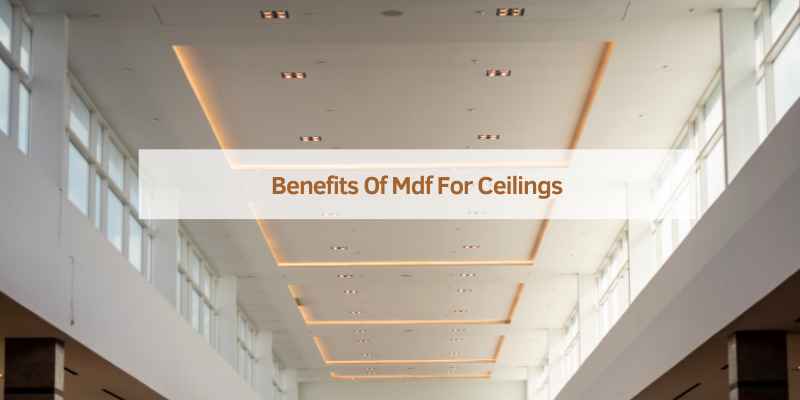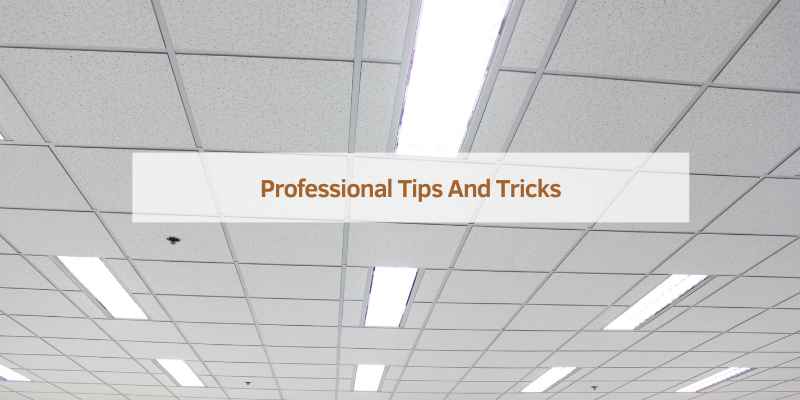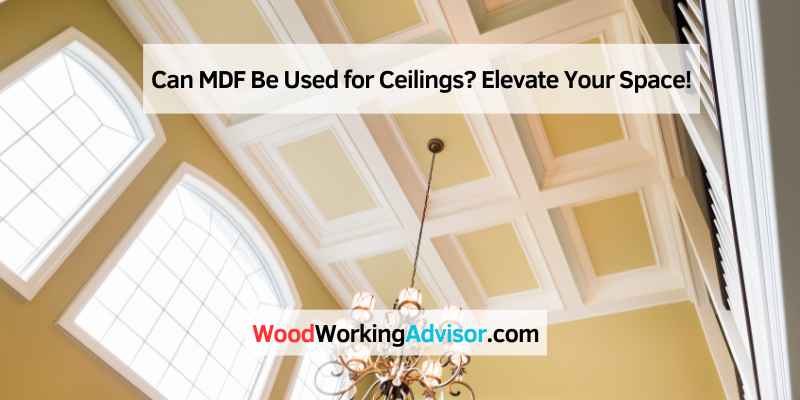Yes, MDF can be used for ceilings. It provides a smooth and uniform surface, ideal for painting or veneering.
Medium Density Fiberboard (MDF) is a versatile material, often used in interior design. Its smooth texture and uniformity make it perfect for ceilings. MDF is easy to work with and can be painted or veneered to match any decor. It’s also more affordable than solid wood.
Due to its dense composition, it offers soundproofing benefits. Additionally, MDF is durable and resistant to warping, making it a reliable choice for ceiling installations. Proper sealing and maintenance can ensure its longevity. MDF is a practical and cost-effective option for enhancing your ceiling’s appearance and functionality.
Benefits Of Mdf For Ceilings
Using MDF (Medium-Density Fiberboard) for ceilings has become popular due to its many advantages. MDF offers a range of benefits that make it an excellent choice for ceiling installations. Below, we explore the key benefits of MDF for ceilings.
Cost-effectiveness
MDF is more affordable than many other ceiling materials. It provides a cost-effective solution without compromising quality. This makes it ideal for budget-conscious projects.
Using MDF can significantly reduce overall project costs. It allows for high-quality installations at a fraction of the price.
Smooth Finish
MDF offers a smooth and uniform surface. This makes it perfect for painting or finishing. The smooth finish ensures a sleek and polished look for any ceiling.
The material’s consistency eliminates the need for extensive sanding. It helps save time and effort during installation.
Versatility In Design
MDF is highly versatile. It can be easily cut, shaped, and customized to fit any design. This allows for creative and unique ceiling designs.
Whether it’s a simple or intricate design, MDF can accommodate various styles. It provides flexibility in design choices.
| Benefit | Description |
|---|---|
| Cost-Effectiveness | More affordable than other materials, reduces overall project costs. |
| Smooth Finish | Offers a smooth, uniform surface perfect for painting or finishing. |
| Versatility in Design | Highly versatile, can be cut and shaped for various designs. |
- Affordable – Ideal for budget-conscious projects.
- Smooth Surface – Perfect for a polished look.
- Customizable – Fits any design requirement.

Installation Considerations
When considering MDF for ceiling installations, there are several important factors to keep in mind. These factors ensure both the safety and longevity of your ceiling. Below are key considerations to keep in mind during installation:
Weight And Support
MDF is heavier than traditional ceiling materials. This makes it crucial to ensure your ceiling can support the weight. Use strong joists and beams to provide adequate support.
Here’s a quick comparison:
| Material | Average Weight (per sq. ft.) | Support Required |
|---|---|---|
| Drywall | 1.6 lbs | Standard |
| MDF | 2.8 lbs | Extra |
Cutting And Customization
MDF is easy to cut and shape for unique ceiling designs. Use standard woodworking tools for precise cuts. Ensure your measurements are accurate to avoid wastage.
Tips for cutting MDF:
- Use a sharp saw blade
- Wear a dust mask
- Sand the edges for a smooth finish
Safety Measures
Safety is crucial during installation. MDF produces fine dust particles when cut. These particles can be harmful if inhaled.
Always follow these safety measures:
- Wear a dust mask
- Use safety goggles
- Work in a well-ventilated area
These steps ensure a safe and efficient installation process.
Design Possibilities With Mdf
MDF, or Medium-Density Fiberboard, offers many design possibilities for ceilings. It’s versatile, cost-effective, and easy to work with. You can create unique and beautiful ceilings with MDF. Let’s explore the different ways you can use MDF for ceiling design.
Paint And Texture Options
MDF can be painted in any color you like. This makes it easy to match your ceiling with your room’s decor. You can also add texture to your MDF ceiling. Use textured paint or wallpaper to create a unique look.
- Bold Colors: Use bright colors to make your ceiling stand out.
- Textured Paint: Add depth with textured paint.
- Wallpaper: Apply wallpaper to MDF for a patterned look.
Incorporating Lighting
MDF ceilings can easily incorporate different types of lighting. You can add recessed lights, pendant lights, or even LED strips. This can make your ceiling look modern and stylish.
- Recessed Lights: Create a sleek look with recessed lights.
- Pendant Lights: Hang pendant lights for a dramatic effect.
- LED Strips: Use LED strips for a modern touch.
Creating Architectural Interest
MDF can be used to create architectural interest on your ceiling. You can add beams, coffers, or decorative panels. This can make your ceiling look more detailed and sophisticated.
| Design Element | Effect |
|---|---|
| Beams | Adds a rustic or traditional look. |
| Coffers | Creates a grid pattern for a classic look. |
| Decorative Panels | Adds intricate details for a luxurious feel. |
Mdf Ceiling Durability
Medium Density Fiberboard (MDF) is popular for ceilings. Many homeowners and builders love it. But how durable is an MDF ceiling? Let’s explore its durability.
Resistance To Damage
MDF has a smooth surface. It is less likely to splinter or crack. This makes it a good choice for ceilings. It can handle small impacts well. MDF is also resistant to warping. Unlike natural wood, it does not easily bend or twist. This quality adds to its durability.
Lifespan And Maintenance
An MDF ceiling can last for many years. Proper care and maintenance are key. Regular dusting and occasional cleaning keep it looking new. You can use a soft cloth or a vacuum with a brush attachment. Avoid using too much water. Excessive moisture can damage MDF.
Handling Moisture
MDF is not naturally water-resistant. It can swell or warp when exposed to moisture. For areas with high humidity, like bathrooms, MDF needs extra protection. You can seal it with a water-resistant coating. This helps prevent moisture damage. Always check for leaks in the ceiling. Fix any issues promptly to protect the MDF.
Below is a table summarizing the key points:
| Aspect | Details |
|---|---|
| Resistance to Damage | Resistant to splintering, cracking, and warping |
| Lifespan | Long-lasting with proper care |
| Maintenance | Regular dusting and occasional cleaning |
| Handling Moisture | Needs sealing for water resistance |
By understanding these aspects, you can decide if MDF is right for your ceiling project.
Environmental And Health Factors
MDF, or Medium Density Fiberboard, is popular in interior design. It is affordable and versatile. But, it’s important to consider the environmental and health factors. This is crucial when using MDF for ceilings.
Sustainability Of Mdf
MDF is made from wood fibers. These fibers are often from recycled wood. This makes MDF a sustainable choice. Using recycled materials helps reduce waste. MDF production also uses less energy compared to solid wood.
But, the sustainability of MDF depends on the source of the wood. It’s better to choose MDF from certified sources. Look for FSC or PEFC certifications. These ensure the wood comes from well-managed forests.
Indoor Air Quality Concerns
Indoor air quality is a big concern with MDF. MDF contains formaldehyde, a harmful chemical. Formaldehyde can cause health issues. These include respiratory problems and allergies.
Choose MDF with low formaldehyde emissions. Look for MDF labeled E1 or CARB2. These labels indicate lower formaldehyde levels. You can also use sealants to reduce emissions.
Proper ventilation is key. Make sure the room has good airflow. This helps to reduce indoor air pollution.
| Factor | Consideration |
|---|---|
| Sustainability | Choose certified MDF (FSC, PEFC) |
| Air Quality | Opt for low formaldehyde MDF (E1, CARB2) |
Case Studies
The versatility of Medium Density Fiberboard (MDF) makes it a popular choice for various applications, including ceilings. This section explores how MDF has been successfully used in different settings. We will look at residential applications, commercial projects, and innovative designs.
Residential Applications
Many homeowners choose MDF for their ceilings. It offers a smooth and uniform surface. The material is easy to paint, allowing for a wide range of finishes. In one case study, a family renovated their living room with MDF ceiling panels. The result was a modern and sleek look. They painted the MDF in a light shade, making the room appear more spacious.
Another family opted for an MDF ceiling in their kitchen. The moisture-resistant properties of MDF made it an excellent choice. They installed recessed lighting, which complemented the ceiling’s smooth finish. The kitchen became brighter and more inviting.
Commercial Projects
Businesses also find MDF suitable for ceilings. It is durable and cost-effective. A notable example is a restaurant that used MDF panels for its ceiling. The restaurant needed a material that could withstand wear and tear. MDF met their needs perfectly. The owners chose a dark, matte finish that added elegance to the dining area.
In another case, an office building used MDF for its conference rooms. The smooth surface allowed for easy installation of acoustic panels. This improved sound quality, making meetings more effective. The MDF ceiling also provided a clean and professional look.
Innovative Designs
Creative architects and designers often use MDF for unique ceiling designs. One innovative project involved a custom-designed MDF ceiling in a boutique store. The ceiling featured intricate patterns carved into the MDF panels. This design element attracted customers and enhanced the store’s branding.
Another example is a theater that used MDF for a wave-like ceiling structure. The flexibility of MDF allowed for this complex design. The finished ceiling not only looked stunning but also improved the theater’s acoustics.
| Application | Example | Benefits |
|---|---|---|
| Residential | Living Room, Kitchen | Smooth finish, Moisture-resistant, Easy to paint |
| Commercial | Restaurant, Office | Durable, Cost-effective, Professional look |
| Innovative Designs | Boutique Store, Theater | Customizable, Unique patterns, Improved acoustics |
Professional Tips And Tricks
Installing MDF on ceilings can be a great choice. It adds elegance and a smooth finish. Let’s dive into some professional tips and tricks to make your installation seamless and flawless.
Best Practices For Installation
Proper preparation is key. Ensure the ceiling is clean and dry before starting. Use a stud finder to locate joists. Mark these spots as they will be your anchor points.
Use the right tools. A saw, drill, and adhesive are essential. Make sure to measure twice and cut once. This prevents errors and waste.
Apply adhesive generously. A strong bond ensures the MDF stays in place. Use construction adhesive on the back of each panel.
Screw into joists. Secure each panel by screwing into the marked joists. This provides extra support and stability.
Avoiding Common Mistakes
Don’t skimp on adhesive. Insufficient adhesive can cause panels to sag or fall. Use enough to cover the back of each panel.
Avoid cutting corners. Always cut panels accurately. Misaligned cuts can ruin the final look.
Check for gaps. Gaps between panels can be unsightly. Use a level to ensure each panel is flush with the next.
Let adhesive dry. Allow the adhesive to cure fully before painting or adding finishing touches. This ensures a strong bond.
Expert Recommendations
Choose high-quality MDF. Not all MDF is created equal. Opt for moisture-resistant MDF for added durability.
Prime before painting. MDF soaks up paint. Priming first provides a smooth, even finish.
Consider using molding. Molding hides any imperfections and adds a polished look.
Hire a professional. If unsure, consult with an expert. They have the experience and tools to do the job right.
| Tip | Details |
|---|---|
| Proper Preparation | Clean and dry surface, locate and mark joists. |
| Right Tools | Saw, drill, adhesive, measuring tape. |
| Generous Adhesive | Ensure strong bond, cover back of each panel. |
| Screw into Joists | Secure each panel, extra support and stability. |

Frequently Asked Questions
Can You Hang Mdf On A Ceiling?
Yes, you can hang MDF on a ceiling. Ensure proper support and secure fastening to prevent sagging.
What Type Of Wood Is Best For Ceilings?
Cedar and pine are excellent choices for wood ceilings. They offer durability, natural beauty, and resistance to insects.
How To Fix Mdf Ceiling?
To fix an MDF ceiling, first locate the damaged area. Clean it thoroughly. Apply wood filler, then sand it smooth. Prime and paint the repaired section to match the rest of the ceiling. For extensive damage, consider replacing the affected MDF panels.
Ensure proper ventilation during the process.
What Is Mdf Board For Ceiling?
MDF board for ceiling is a medium-density fiberboard used for creating smooth, durable, and aesthetically pleasing ceiling surfaces. It’s easy to install, paint, and customize, making it a popular choice for modern interiors. MDF boards offer cost-effective, versatile, and reliable ceiling solutions.
Conclusion
MDF can be a viable option for ceilings, offering affordability and versatility. Ensure proper installation to avoid sagging or moisture issues. Consider your space’s specific needs and consult professionals for best results. With the right approach, MDF can enhance your ceiling’s appearance and functionality effectively.


